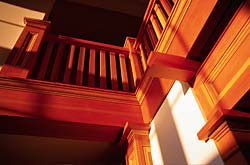Within Home Improvement Industry, Manufacturers may be Hit Hardest
See if We Have Top-Rated
Home Improvement Professionals in Your Area

Seemingly ever sector of the U.S. economy is evaluating how the current recession stands to affect their industry. Of course, virtually anything tied to the current U.S. housing market is in for a rough time, but within this economic sector, home improvement itself may weather the storm with relative ease. Consumer resources that gauge home improvement demand show that homeowners have largely maintained their necessity for home repairs and their appetite for home improvements. Meanwhile, the Home Improvement Research Institute has revised estimates for the Home Improvement Products Market to indicate a 0.7 percent drop in 2008 and a forecasted drop of 3.1 percent in 2009. The cumulative direction of these statistics shows that within the home improvement industry, manufacturers that rely on homeowners' expenditures for home improvement materials are likely to be hit hardest.
Home Improvement and Remodeling Demand
The Joint Center for Housing Studies (JCHS) at Harvard University has forecast that by the second quarter of next year remodeling expenditures will be down 12 percent. That said, the current home improvement and remodeling demand has shown remarkable resiliency to the economic recession thus far. HomeAdvisor, the leading online resource connecting homeowners and home improvement contractors, has shown home improvement demand has risen nearly across the board. In the latter half of 2008, homeowners actively seeking contractors for home additions and remodels outpaced the previous year by more than 10 percent, roofing demand increased by 13 percent, and HVAC services increased by an eye-catching 51 percent.
Product Costs and Manufacturers
If, as this research suggests, homeowners are undertaking home improvement projects with relatively the same frequency but spending less, it stands to reason that they're finding ways to cut corners that reduce the overall price tag. Fewer luxury materials such as hardwood flooring, slate and tile roofing, granite and marble counters, and high-dollar fixtures means less revenue for many home improvement manufacturers. Adding salt to these wounds, previously rosy economic forecasts for the home improvement and building industries led many manufacturers to invest deeply in their research and development departments. New and innovative products may temporarily outprice consumers' spending power. Of course, by the same logic, it stands to reason that manufacturers that focus on low-cost alternatives—carpet, linoleum, laminate countertops, ceramic tile, stock cabinets—may maintain or even increase their revenues during the current recession.
Change the look and feel of your home! Use this link for a custom
Home Remodel
Home Improvement vs. Home Building
It's not hard to explain why home improvements are still in demand during tough economic times. Even cash-strapped homeowners will pay to repair leaky roofs, replace burst pipes, and install replacement windows and insulation that stands to decrease their monthly utility bills. Despite the JCHS forecast, even selective home improvements, such as home remodels, are likely to show some resistance to the economic recession, as the precipitous decline in the real estate market persuade homeowners to delay putting their home on the market, instead putting their income back into their current homes.
While the home improvement industry is, in many ways, resistant to economic recession, home builders are more directly affected by the housing market and their own recent overestimations of housing demand. With new housing starts at their lowest levels since WWII, this downturn alone explains much of the hardship home improvement manufacturers may face this year. The common ground between home builders and manufacturers is the lumber industry. Home building typically accounts for about 45 percent of the lumber used each year, and this year, several lumber mills may very well experience the worst decline they've ever recorded.
Cheaper Projects may Threaten Trends in Green Remodeling
Unfortunately, many of the ways in which homeowners cut corners on their home improvements reduce the green qualities of these projects. Recycled glass tile and countertops tend to be significantly more expensive than basic ceramic tile or laminate counters. Even homeowners aware of the long-term benefits may lack the financial resources to install a furnace or air conditioning unit with a high energy-efficiency rating. This tendency to fail to look beyond the price tag becomes even stronger with washers and dryers, refrigerators, and other common household appliances. Worse yet, homeowners forced to pinch every last penny may not be making the best choices for the long-term well-being of their home, thus reducing their general spending power for years to come.
More Tips & Advice For Your Home
- Related Articles
- Recent Articles

